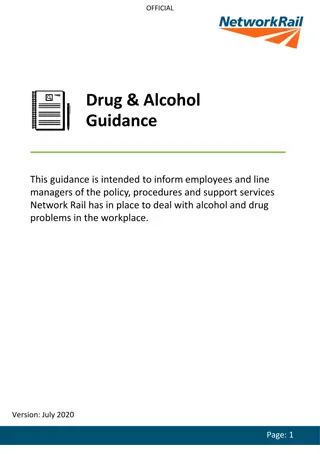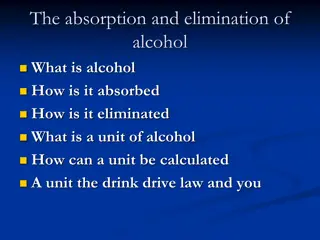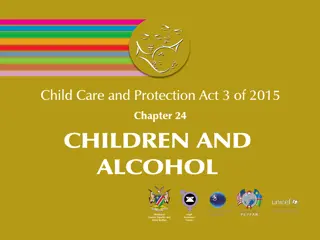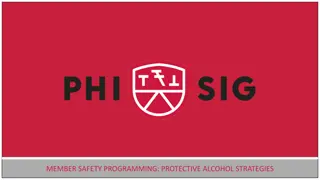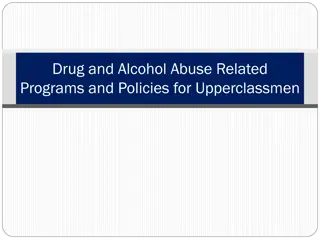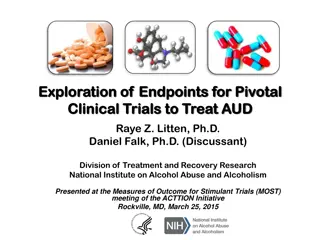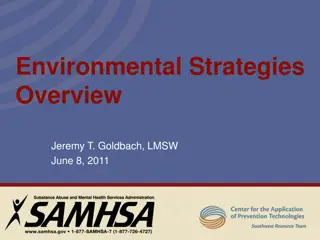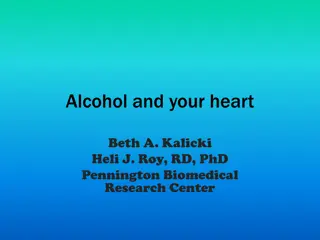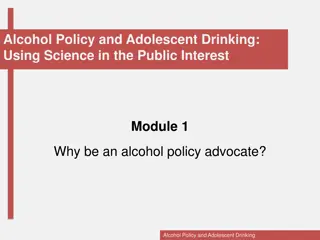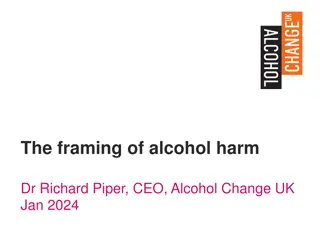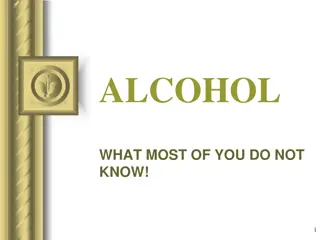
Understanding the Effects of Alcohol Consumption on the Body
Discover the impact of alcohol on the body, from how body size and gender influence alcohol effects to the pathway alcohol takes through the body. Learn about binge drinking, alcohol poisoning, interactions with food and medicine, and more.
Download Presentation

Please find below an Image/Link to download the presentation.
The content on the website is provided AS IS for your information and personal use only. It may not be sold, licensed, or shared on other websites without obtaining consent from the author. If you encounter any issues during the download, it is possible that the publisher has removed the file from their server.
You are allowed to download the files provided on this website for personal or commercial use, subject to the condition that they are used lawfully. All files are the property of their respective owners.
The content on the website is provided AS IS for your information and personal use only. It may not be sold, licensed, or shared on other websites without obtaining consent from the author.
E N D
Presentation Transcript
Reasons to Drink/Reasons to Abstain To Drink .. Not to drink ..
The effects that alcohol have on a person are influence by a number of factors:
Body Size The same amount of alcohol has a greater effect on a smaller person than it does on a larger person.
Gender Alcohol moves faster into the bloodstream in females because males carry more water in their bodies. Males 61% of your bodyweight is water. Females 52% of your bodyweight is water.
Time Frame The consumption of several drinks in a short period of time will cause a person to become intoxicated quicker.
Binge Drinking The consumption of several drinks in a very short period of time.
Pathway of Alcohol Activity The Path of Alcohol in the body Mouth: alcohol enters the body. Stomach: some alcohol gets into the bloodstream in the stomach, but most goes on to the small intestine. Small Intestine: alcohol enters the bloodstream through the walls of the small intestine. Heart: pumps alcohol throughout the body. Brain: alcohol reaches the brain. Liver: alcohol is oxidized by the liver at a rate of about 0.5 oz per hour. Alcohol is converted into water, carbon dioxide and energy.
Amount A large quantity of alcohol causes the levels in the bloodstream to rise quickly. If it becomes to high, alcohol poisoning can occur.
Food Food slows down(absorbs) the passage of alcohol into the bloodstream.
Medicine Mixing alcohol with prescription or non-prescription drugs will intensify the effects of alcohol. Interactions between the two substances can cause potentially very serious medical consequences.
Alcohol Terms to Know: Blood Alcohol Concentration (BAC): The amount of alcohol present in a person s bloodstream.
Breathalyzer: A device used to estimate BAC from a breath sample.
Intoxicated Physically and/or mentally impaired from the consumption of alcohol. For anyone Under 21: BAC above 0 is illegal For anyone Over 21: .08 is considered intoxicated
DWI DWI: Driving while intoxicated. DWI s are issued to those who are driving above the legal limit. (.08) BAC levels of .08 or higher are considered evidence of intoxication. BAC levels of .18 or higher are considered Aggravated DWI. BAC levels of .05 to .07 are considered DWAI (Driving While Ability Impaired) and can be classified as caused by alcohol, other drugs, or a combination. New York state also has a Zero Tolerance Law for drivers under the age of 21.
DUI: Driving under the influence. DUI s are issued when a driver is on drugs that impair their ability to operate the vehicle safely. (narcotics, prescriptions drugs, etc).
Fetal Alcohol Syndrome Fetal alcohol syndrome (FAS) is a condition that results from alcohol exposure during pregnancy. Problems that may be caused by fetal alcohol syndrome include physical deformities, mental retardation, learning disorders, vision difficulties and behavioral problems.
Short Term Effects of Alcohol Slurs speech Impairs reflexes and reaction time Impairs judgement Increases frequency of urination Causes nausea and vomiting May cause anger, violence, or mood swings Relaxes the eye muscles, making it difficult to focus
Long Term Effects of Alcohol Causes liver damage Causes heart disease Causes irreversible brain and nerve damage Causes cancer of the stomach Causes malnutrition Causes diseases of the stomach, digestive system, and pancreas Results in a vitamin deficiency



